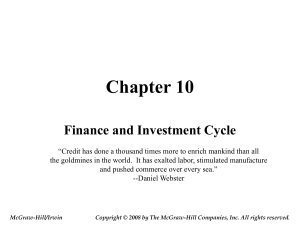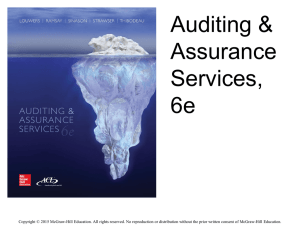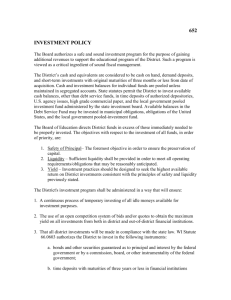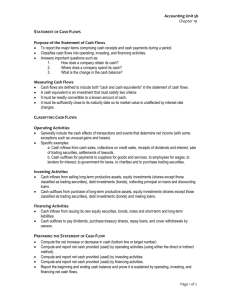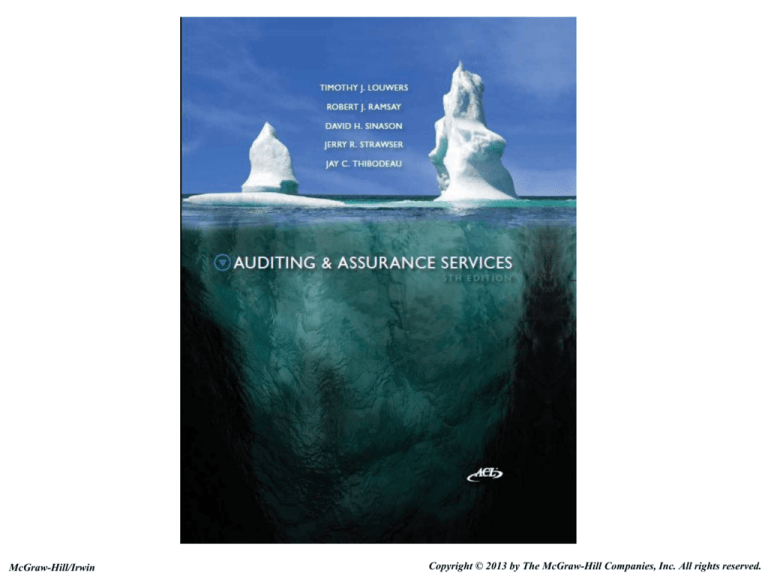
McGraw-Hill/Irwin
Copyright © 2013 by The McGraw-Hill Companies, Inc. All rights reserved.
Chapter 10 Finance and Investment Cycle
Learning Objectives
1. Describe the finance and investment cycle,
including typical source documents and controls.
2. Give examples of tests of controls over debt and
stockholders’ equity transactions and investment
transactions.
3. Describe substantive procedures for finance and
investment accounts.
4. Describe common errors and frauds in the
accounting for capital transactions and
investments, and design audit and investigation
procedures for detecting them.
10-2
INVESTING AND
FINANCING CYCLE
• Concerned with transactions related to the
use of the organization's funds (investing)
and sources of those funds (financing) other
than operations.
• Accounts affected by investing and
financial cycle transactions include
investments in securities; notes and bonds
payable; and, stockholders' equity accounts.
10-3
Inherent Risks
•
•
•
•
•
Lease Accounting
Loan covenants
Related party transactions
Complex transactions
Impairments
10-4
Investment and Finance
Activities
•
•
•
•
•
•
Financial Plan
Capital budget
Raise capital
Operate business (all other cycles)
Mergers and acquisitions
Investment of excess funds
10-5
Control Considerations
• Transactions authorized by BOARD OF DIRECTORS
• Documentation:
– Investments in securities: BROKER'S ADVICE
– Property, plant and equipment: VENDOR'S INVOICE
(for purchased PPE) or INTERNAL COST RECORDS
(for manufactured PPE)
– Bonds and notes payable: Documentation from
DEBTHOLDERS
– Stockholders' Equity: Documentation from
REGISTRAR
• CASH RECEIPTS/DISBURSEMENTS JOURNALS
10-6
Finance and Investment Cycle:
Control Procedures
• Physical Controls
– Securities CUSIP numbers recorded
– Securities recorded in the client's name
– Securities held by an independent custodian or in
a secure location
– Access to safe-deposit box requires more than
one employee
– Physical items periodically compared to detail
records
– Cash receipts from Investing and Financing cycle
transactions deposited intact and daily (electronic
transfer preferred)
10-7
Finance and Investment Cycle:
Control Procedures (cont.)
• Separation of Duties
– Transactions AUTHORIZED by the Board of
Directors
– General Accounting RECORDS transactions
– A separate function or external custodian has
CUSTODY of stock and bond certificates
• Performance Reviews
– Compare current investing and cycle transaction
data against prior-year data or expected data
– Compare revenue and expenses against
organization standards or expectations.
– Compare transactions on monthly statement to cash
receipts/disbursements
10-8
CONTROL OVER
ACCOUNTING ESTIMATES
•
•
•
•
•
•
Communication of need for estimate
Accumulate data
Qualified personnel
Review and approval
Comparison to results
Compare with plans
10-9
SUBSTANTIVE TESTS–INTERESTBEARING LIABILITIES
• Agree to BEGINNING BALANCE and CONFIRM with
holders or makers.
• LOAN PROCEEDS
– VOUCH to cash receipts
– Recalculate Discount/Premium
– Confirm IBL, examine note
• LOAN PAYOFF
– Recalculate Interest Expense
– Recalculate Gain/Loss on Retirement
– Verify cash disbursements
10-10
INTEREST-BEARING
LIABILITIES
• INTEREST PAYMENTS
– Recalculate Interest Expense
• Search for UNRECORDED liabilities
– Inquiry of management
– Bank confirmations
– Unusual amounts of interest expense
– Large receipts of cash during the year
• Ensure DEBT COVENANTS are met.
– Inspect loan agreements.
– Consider GOING CONCERN implications if not met.
– Ensure proper presentation and disclosure.
10-11
AUDITING STOCKHOLDER'S EQUITY
• Overview of audit approach
– EXTERNAL PARTIES involved in record keeping
– Transactions must be authorized by the BOARD OF DIRECTORS
– Transactions must be consistent with the client's ARTICLES OF
INCORPORATION
• PAID-IN CAPITAL
– Agree balances to prior year documentation
– Examine issuances and repurchases of capital stock
• Verify distribution of proceeds between CAPITAL STOCK and
ADDITIONAL PAID-IN CAPITAL
• Examine CASH RECEIPTS and CASH DISBURSEMENTS records
• Determine that all transactions are RECORDED (TRACE from BOD minutes)
• Verify that all transactions are PROPERLY AUTHORIZED
• RETAINED EARNINGS
–
–
–
–
Agree beginning balance with prior year documentation
Verify the appropriateness of prior-period adjustment treatment
Trace net income/loss to INCOME STATEMENT
Ensure that DIVIDENDS are properly authorized by BOARD OF DIRECTORS
10-12
Auditing Investments:
Substantive Procedures
•
•
•
•
Agree beginning balances to Prior Year Documentation
Review client’s policies and procedures
– Identify those individuals authorized to execute trades with brokers
– Identify individuals who reconcile brokerage accounts with company records
and ensure they are independent.
Purchases of investments
– VOUCH to BROKER'S ADVICE (Statement)
– Examine BOARD MINUTES for authorization
Sales of investments
– VOUCH to BROKER'S ADVICE, CASH RECEIPTS RECORDS, and
BOARD MINUTES
– Recalculate gain or loss on sale
– Read minutes for sales of Investments and trace to recording
– Trace cash receipts to cash receipts journal and bank statement
10-13
Auditing Investments:
Substantive Procedures (cont.)
•
•
•
•
Determine MARKET VALUE
– Obtain 12/31 market price from Wall Street Journal or other sources
– Evaluate for possible PERMANENT DECLINES
PHYSICALLY INSPECT or CONFIRM securities
– Verify CUSIP Numbers to ensure that there were no unrecorded sales and
subsequent repurchases
– Recorded in company name
– Can inspect at interim, if safe-deposit box
Verify DIVIDEND REVENUE
– Review stocks held by client for dividend payments (e.g. Moody's, Standard
& Poor's, CNBC.com).
– If securities held by broker review monthly statements for dividends.
– Trace dividend received to CASH RECEIPTS records
Evaluate presentation in BALANCE SHEET (short-term vs. long-term asset)
10-14
Trouble Spots in Audits of
Investments
• Valuation of investments
– at cost or market value is not always evident
– value impairment that is other than temporary.
• Propriety, effectiveness, and risk disclosure of
derivative securities used as a hedges
• Determination of the fair value of derivatives and
securities, including valuation models and the
reasonableness of key assumptions.
• Determination of significant influence relationship
for equity method investments.
10-15
Derivative Investments, Hedging Activities,
and Investments in Securities (SAS 92)
• Inquiries about the nature of investments and the
reasons for holding them, especially hedging activities.
• Classification affects the accounting treatment of
market values and the unrealized gains and losses on
investments.
• Due to the complexity of Accounting for Derivative
Securities and Hedging Activities, auditors may need
special skills or knowledge to:
– understand client hedging transactions
– ensure that effective controls are in place
– to audit the transactions.
10-16
Auditing Fair Value
Measurements
• Management’s responsibility.
• Market-based values preferred
• If not available—use assumptions market
would have used.
• If not known—management can use their
own assumptions
– if no contrary data
10-17

